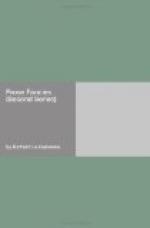Yellow is becoming more and more dominant in decoration—in wall-papers, and flowers cultivated with decorative intention, such as chrysanthemums. And one can easily understand why: seeing that, after white, yellow reflects more light than any other colour, and thus ministers to the growing preference for light and joyous rooms. A few yellow chrysanthemums will make a small room look twice its size, and when the sun comes out upon a yellow wall-paper the whole room seems suddenly to expand, to open like a flower. When it falls upon the pot of yellow chrysanthemums, and sets them ablaze, it seems as though one had an angel in the room. Bill-posters are beginning to discover the attractive qualities of the colour. Who can ever forget meeting for the first time upon a hoarding Mr. Dudley Hardy’s wonderful Yellow Girl, the pretty advance-guard of To-Day? But I suppose the honour of the discovery of the colour for advertising purposes rests with Mr. Colman; though its recent boom comes from the publishers, and particularly from the Bodley Head. The Yellow Book with any other colour would hardly have sold as well—the first private edition of Mr. Arthur Benson’s poems, by the way, came caparisoned in yellow, and with the identical name, Le Cahier Jaune; and no doubt it was largely its title that made the success of The Yellow Aster. In literature, indeed, yellow has long been the colour of romance. The word ‘yellow-back’ witnesses its close association with fiction; and in France, as we know, it is the all but universal custom to bind books in yellow paper. Mr. Heinemann and Mr. Unwin have endeavoured to naturalise the custom here; but, though in cloth yellow has emphatically ‘caught on,’ in paper it still hangs fire. The ABC Railway Guide is probably the only exception, and that, it is to be hoped, is not fiction. Mr. Lang has recently followed the fashion with his Yellow Fairy Book; and, indeed, one of the best known figures in fairydom is yellow—namely, the Yellow Dwarf. Yellow, always a prominent Oriental colour, was but lately of peculiar significance in the Far East; for were not the sorrows of a certain high Chinese official intimately connected with the fatal colour? The Yellow Book, the Yellow Aster, the Yellow Jacket!—and the Yellow Fever, like ‘Orion’ Home’s sunshine, is always with us’ somewhere in the world.’ The same applies also, I suppose, to the Yellow Sea.




